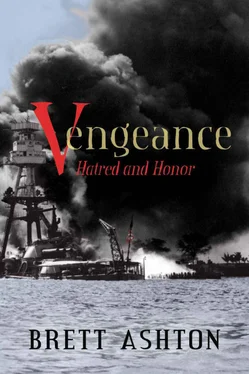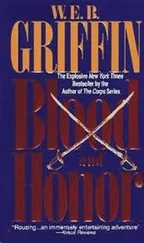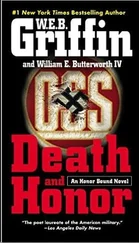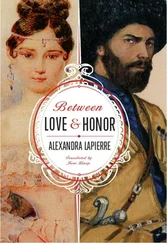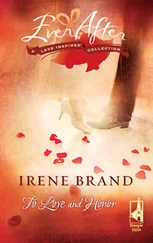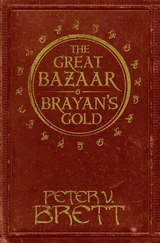Pow, pow, pow, pow, pow, pow, pow, pow! The gun went off rapidly eight times then went empty, with the slide locking open. The can danced in the air and fell to the deck. I slapped the next magazine into the gun, closed the slide, put the safety on, and holstered my weapon. When I picked up the can and showed it to them, it had eight distinctly different holes in it, four entrance holes, and four exit holes. I held it up for the captain and the XO and said, “There you go, gentlemen.” The jaws of the two marines and the XO went slack. The captain was grinning from ear to ear.
“There you go,” he said to the XO. “Pay up.”
The XO handed him a twenty and stood there, shaking his head, still in disbelief. “That is the most incredible damned thing I have ever seen!” he said.
The captain said to me, “You have no idea how disappointed I would have been in my old friend Commander Kenworthy if you had missed. I really think you might be able to shoot a Jap pilot right out of the sky with that thing someday.”
“I’ll get him right between the eyes, sir,” I replied as the two marines began to laugh.
Over the next couple of days, the rumor of what happened spread throughout the ship. By the time it made it back to me, I had earned a nickname amongst the crew. I was thereafter called “Lieutenant Commander ‘Between the Eyes.’”
On the 24th of August, 1942, the fortunes of war found us screening for the Enterprise in the area of the Eastern Solomons. The carrier Saratoga was there as well. Just as I had predicted would happen, the battleships were serving as large anti-aircraft gun platforms to defend the carriers from air attack. I wondered if the Showboat would ever have a chance to duke it out on the open seas with a Japanese big-gun battleship as she was designed to do, or if these big battlewagons were going obsolete altogether.
We had been at sea for quite some time, and the crew was becoming tired of the continuous training and drilling. They were spoiling for an actual fight, but none had yet materialized. Days turned to weeks, which turned to months, without a single engagement.
The crew was becoming very frustrated by the total lack of action thus far, and some were even expressing that somehow the war might be over before they actually had a chance to fight. It was as though they were thinking that somehow there would be a shortage of Japs to kill, and they wanted to get in there and do their share while they still had the chance. There was too much of a feeling of invulnerability on board for me. The North Carolina was considered to be the most powerful weapon on Earth at the time, and “nobody could touch us,” they said.
While I was optimistic because of the enthusiasm they displayed in their training, I did not share their feelings in general. In spite of the intensive drilling, this was still an untested crew, and nobody knew how they would respond in actual combat. I was one of the very few onboard who had actually experienced combat, and that experience was still an open wound to me. The recruiters’ posters and newsreels that started coming out at the time made it all look and sound like it was some kind of glorious thing to be in combat. But the reality of it, once you have been there, is quite different.
Sure I wanted to kill Japs. I wanted to shoot at them with everything the Showboat had to offer. But my mind was full of the desire to retaliate for the attack on Pearl in a way most of the rest of the crew could not yet relate to. Hopefully, they would never have to. It is a hard thing to survive the loss of a ship you served on. My mind was still full of the images of the men I knew who died on board the Oklahoma . And those images burned in my soul. However, I was not afraid to be there in the least bit. I was too angry for fear.
The difference, I suppose, was that I had been in combat and lost . I had one of these battleships shot right out from under me, and we, the crew of the Oklahoma , along with all the rest of the crews of the ships in Pearl Harbor during the attack, thought we were invulnerable, too. But the Okie was still upside-down in Pearl Harbor with a third of her crew still entombed within, and my battle scars were still very visible.
Some of the younger officers and crew asked me what combat was like, almost with a bit of a gleam of admiration in their eyes. I tried to tell them in a way that would make them ready without evoking too much fear in them. But without that fear, how could somebody ever really understand?
There is a certain intangibility of thought that goes with an experience like war that seems to defy explanation. How do you describe to somebody that depth of horror that you can’t even reach after the fact yourself? And how do you train somebody to continue in a firefight with that kind of horror pressing in all around them? The average man on this crew was just nineteen years old. Just a few short months ago, these men were digging around on the farm in the States or going to high school. How do you relate to them the experience of somebody getting blown apart or burned to a crisp right before your very eyes?
In the long run, I thought it would work out better just to drill them on their respective tasks so their attention would stay on their jobs, no matter what happened. Then wait for them to have some actual experience and let them sort it out on their own.
On the plus side, there was a slow trickle of news coming in about the rest of the war. We had won the Battle of Midway, largely because of being smiled upon by Lady Luck, and that tended to boost morale. On the other hand, once again because of luck, the United States Navy had just suffered a most humiliating defeat at the Battle of Savo Island. You never can predict the outcome of a battle because of the extreme variables that play into the situation. On one hand, we knew we could put up a good fight. And on the other hand, we also knew, in a glib sort of way, that we could lose. But I was one of the very few men on board who felt the sting of the latter.
I always got a kind of kick out of the recruiting posters. You know the ones—“Fight for your country! And defeat those cowardly Japs!” There was something the recruiting posters didn’t really mention very much. That one thing, which the crew in their enthusiasm wasn’t really thinking about, was the one thing that bothered me to no end. The Japs would be shooting back, and they were very, very good at it. The Empire of Japan had been at war for decades, and the United States had not been at war for decades.
They knew what they were doing. Did we?
Radar on the carriers, for some reason, was not working well that day. Ours was picking up targets at its ultimate maximum distance more as ghosts. Sometimes, we would see them and then they would be gone, just like that. The Japs were looking for us for sure, and there would be no doubt about it when they finally found us. There was just a feeling in the air that on that day we would be bound for combat, and it was going to be intense.
Early in the afternoon, reports started coming in about a Jap carrier that was spotted and attacked. Reports also came in about attacks on Henderson Field on Guadalcanal carried out by carrier-based aircraft. With the strategic importance of the base at Guadalcanal, I was sure we were going to run into a major force of Japanese whose only purpose for being there was to kill us. We were on high alert and about to head into the thick of things. General quarters sounded, and the ship rapidly prepared for battle, only to wait for hours until anything materialized.
At about 1600, Combat Information Center (CIC) called up to my station in Sky Control and reported a large wave of incoming aircraft. I looked over to the Enterprise and saw that they had started launching planes at a very rapid pace. I told the machine gun officer and other crew up there with me to “look sharp; the enemy has found us.”
Читать дальше
